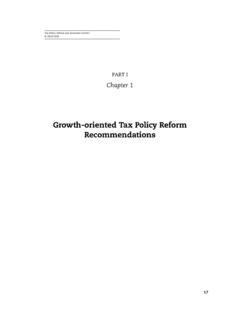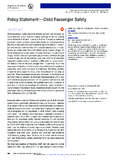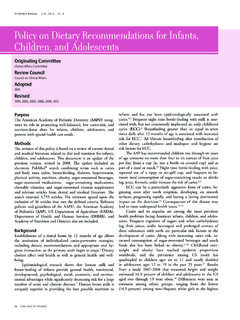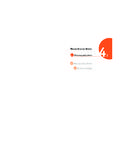Transcription of The TRL Scale as a Research & Innovation Policy …
1 The TRL Scale as a Research & Innovation Policy Tool, EARTO Recommendations 30 April 2014. Contents Introduction .. 2. 1. Understanding Technology readiness Levels .. 3. Different Approaches in Different Organisations .. 3. Different Ways to Define readiness at EU Level .. 5. Limitations of the Use of TRLs and the Need for Adaptation .. 5. The View of EARTO on the Use of TRLs .. 6. 2. RTOs are Active throughout the TRLs 8. RTOs Bridging the Valley of Death .. 8. RTOs Add Value at Every Level of the TRLs Scale .. 9. RTOs Supporting EU Industry's Competitiveness .. 10. RTOs Specific Contribution to Higher TRLs .. 12. 3. Examples of RTOs Working Along The Whole Value Chain .. 13. Conclusion .. 16. Annex 1: TRLs Overview Table .. 17. 1. INTRODUCTION. EARTO members are very active in National and European Research , technology & Innovation programmes. In this capacity they have identified an increased use of the Technology readiness Levels (TRL) Scale as a planning tool for Innovation management.
2 Having significant experience in Innovation creation and management, EARTO members wish to express their views on certain observed limitations and challenges related to the use of TRL as a funding selection and review tool. As every tool, the TRL. Scale has its strengths as well as its clear limitations. The assessment presented here will show that the TRL Scale clearly needs adaptations to fit the funding management purposes given today at EU level. Adaptation is also needed to ensure proper decision-making processes when using the TRL Scale based on the reality of today's European Research & Innovation ecosystem. Accordingly, EARTO members feel that the TRL Scale should be better understood to allow its efficient use in further planning of national and European Research , technology & Innovation policies and associated funding programmes. In this context, the aim of this paper is to offer the EARTO members' and the broader RDI community's understanding of this Scale .
3 RTOs are active throughout the Scale and lead projects in all TRL areas in collaboration with the industry at higher TRLs and academia at lower TRLs. The European Commission is placing emphasis on interactions and convergence across and between the different technologies, non-technological disciplines and their relations to societal challenges. Also user needs will be taken into account in all the fields. Interaction between disciplines, trans-disciplinary and user-centric approaches are all part of the everyday operation of RTOs. Hence, RTOs provide the knowledge and expertise needed to solve societal challenges by binding various technologies together, connecting one technology to various applications useful to different industrial contexts, connecting technologies to non-technological disciplines allowing to take users perspective into account as well as look at solutions bridging commercial interests and society needs. Chapter 1 of this paper describes briefly the background of TRL development and its origins, including some examples of its adaptation to different RDI environments.
4 It is also noted, that TRLs actually in principle exist also outside the Research & Development & Innovation (RDI) context. Most importantly, Chapter 1 presents EARTO members' view on the challenges related to the introduction of TRLs as a funding and review or evaluation tool for Research and Innovation programmes. Chapter 2 presents EARTO members' understanding of the TRLs in their operational context. Further, it demonstrates the role of RTOs in supporting Europe's competitiveness and growth. Chapter 3 consists of case examples further supporting the statements of Chapter 2. Finally, this paper suggests possible ways to look at further adaptation of the TRL Scale to best fit European RDI funding programmes (summary table in annex 1). 2. 1. UNDERSTANDING TECHNOLOGY readiness LEVELS. Today, the TRLs Scale is used as a tool for decision making on RDI investments at EU level. Proper implementation of this scheme requires different ways of making this tool operational by adjusting the definitions (or understanding) of the TRLs levels.
5 The Scale needs to be adapted to the specific purpose of EU funding for RDI programmes as it does not address the well-known feedback mechanisms intrinsic to Innovation processes. This chapter provides an overview of the historical, conceptual and contextual background to the TRL Scale to allow further adaptation of the Scale to fit the purpose of European policymakers. TRL originally developed by NASA to support planning of Space technologies The Technology readiness Level (TRL) Scale was developed during the 1970-80's. The National Aeronautics and Space Administration (NASA) introduced the Scale as a discipline-independent, program figure of merit (FOM) to allow more effective assessment of, and communication regarding the maturity of new technologies 1. In 1974, Stan Sadin developed the first 7 level Scale , which was further refined during the 1990s to the 9 level Scale that has gained widespread acceptance across industry and government. In the middle of the first decade after 2000, the Scale was widely adopted as a system to define the readiness of technologies throughout the international space development community.
6 The TRL Scale was developed to enable assessment of the maturity of a particular technology and the consistent comparison of maturity between different types of technologies. Although various other management tools were already available for the more business orientated readiness , no tool was available to assess which stage of development a technology was in. This proved to be a problem for planning the development and construction of, for example, the Space Shuttle. When, in 1981, the Space Exploration Initiative was announced, there was an even greater need for a systematic approach to communicate the readiness of technology and forecast implementation between the technological Research and mission planning community. Hundreds of people were participating in Research , development, manufacturing and use of space technologies, and a clear mode of communication was needed to manage these technology oriented activities. The TRL Scale has spread to other communities, but with significant adaptation Today there is a clear focus on the commercialisation of Research results.
7 Therefore a tool to help evaluate this process was clearly needed. This fostered the use and further adaptation of the TRLs Scale by communities other than space technology communities. For example, the TRL Scale is used by various organisations, from governmental departments like the US-DOD, US-DOE, ESA to large companies like Boeing and Lockheed Martin. Indeed, it is the key element of many Technology readiness Assessment (TRA) methods. These organisations normally use the US-DOD definitions as a basis, but adapt the precise definitions to suit their needs. DIFFERENT APPROACHES IN DIFFERENT ORGANISATIONS. As described, the TRL Scale originated from the observation that the R&D, operational, and planning communities were faced with problems in communication and synchronisation of scales during technology development for space systems. Development of high-tech technological systems typically depends on the successful synchronised development of the individual technologies needed.
8 If this synchronisation is suboptimal, this will have performance, scheduling and budgetary consequences1. The successful development of an innovative system depends highly on the successful management of the alignment of these individual technology pathways. Assessment of the readiness of the individual technologies will allow risk reduction in budget and planning. This observation was the starting point for the development of the TRL Scale and is one of the drivers for its continued use in technology commercialisation and R&D planning. Today it includes the 9. levels (NASA version)2 shown in the table above. 1. Mankins JC (2009), Technology readiness assessments: A retrospective, Acta Astronautica 65 1216 1223, Pergamon. 2. United States Department of Defence (2011), Technology readiness Assessment (TRA)-guidance Washington. 3. Original TRL Scale is based on assumption that Innovation process is linear The TRL Scale uses a linear approach to Research , development and implementation that is common to the prevailing view of Innovation in early 1970s.
9 The core object of development is a singular technology (component) that is developed and integrated with other technologies in a broader high-tech, complex product ( Mission operation ). Both aspects are a natural consequence of the fact that the TRL Scale originates within the environment of space systems development. Although having its flaws, the TRL Scale is widely used; but it is often adapted to the specific needs of an organisation. An example of this adaption of the TRL approach to the specific needs of the organisation can be found in the US-Department of Health and Human services 3, see Figure 2. The TRL Scale is used as an evaluation and planning mechanism to assess the maturity of a drug and allow communication on the status of a specific drug. Although the TRL Scale is adopted to assess the readiness of Medical Countermeasure Products, an adaptation is made to fill the needs of the organisation. It is clear that the wording and definition of the individual levels are different, but the basic 9 level TRL Scale is used.
10 Several other examples of this more biomedical adaption can be found, by NATO and the US-DOD. Figure 2: Adapted definition of the TRL Scale used by the US Department of Health and Human services. A second type of adaptation can be found in the Guide to TRA published by the US Department of Energy4. In this guide, more biotechnology and energy based aspects are incorporated. Although the 9. levels are still visible, the description again for each level is slightly different, as shown in Figure 3. An example is TRL6: Engineering/pilot- Scale , similar (prototypical) system validation in relevant environment . The US-DoE uses TRL6 as relative levels of technological development , using the different types of R&D taking place during the TRLs, : The first stage includes basic technology Research and covers both the observation of basic principles as well as the first formulation of the technology concept. The second stage focuses on Research to prove feasibility and takes the technology concept through first experiments.







